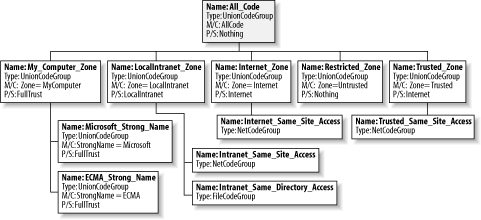9.1 Default Security Policy
| The .NET Framework provides a simple and conservative default security policy that makes use of Microsoft Internet Explorer security zones, which map to the Zone evidence type that we discussed in Chapter 6. 9.1.1 Security Policy FilesThe configuration information for the enterprise, machine, and user policy levels is stored in separate files. Each file contains an XML description of the complete policy level including code groups, named permission sets, and fully trusted assemblies. The runtime uses the XML description to create the policy level's object hierarchy for use during policy resolution, which we discussed in Chapter 8. Table 9-1 lists the default names and storage locations of the policy files on the Windows 2000, Windows NT, Windows 98, and Windows Me platforms. The location of the enterprise and machine policy files depends on the location of the .NET Framework runtime installation. User policy files are user-specific, and their default location depends on where the operating system stores user files. To support users that run multiple versions of the .NET Framework, the location of user policy files also depends on the version of the .NET Framework to which they apply.
When the runtime starts, it looks for the enterprise, machine, and user policy files. If any of the files are missing, the runtime will recreate the missing files automatically using the default configuration settings that we discuss in the following sections. This behavior ensures that the runtime never operates without a complete security policy. However, this approach can also give surprising and undesirable results if you are unaware that one of the policy files has been removed. For example, if somebody manages to delete the enterprise policy file in which you have defined a series of security constraints, the new one created by the runtime will contain the default enterprise-level configuration, which gives all code full trust.
9.1.2 Named Permission SetsThe default enterprise, machine, and user policy levels all contain the set of named permission sets listed in Table 9-2. We summarize the permissions granted by each permission set, but refer you to the .NET Framework SDK documentation for exact details. All of these permission sets except Everything are immutable.
9.1.3 Enterprise and User Policy Code GroupsThe default security policy does not rely on the enterprise and user policy levels to enforce code-access security. Both the default enterprise and user policy levels consist of a single code group named All_Code, which has a membership condition of AllCode and grants its members the FullTrust permission set. This means that without the default machine policy (discussed next), any code regardless of the evidence it presents can perform any action and access any resource. 9.1.4 Machine Policy Code GroupsIn the interest of simplicity, the default security policy concentrates all security decisions in the machine policy level. The code group hierarchy of the machine policy level is oriented around Microsoft Internet Explorer security zones. Figure 9-1 shows the group hierarchy of the default machine policy. The root code group, named All_Code, gives all code the Nothing permission set. Below the All_Code root node are five code groups one for each value of Zone evidence. Internet_Zone and Trusted_Zone use child code groups of type NetCodeGroup and FileCodeGroup to grant code permission to the URL and web site from where they where downloaded; see Chapter 8 for a description of the different types of code groups. Figure 9-1. Default machine policy code group hierarchy
9.1.5 Fully Trusted AssembliesThe following is a list of assemblies contained in the fully trusted assemblies list of the default enterprise, machine, and user policy levels. Each of these assemblies contains classes that may be used during the policy-resolution process. You should not remove any of these assemblies from the fully trusted list, as this will almost certainly cause problems during policy resolution:
|
EAN: 2147483647
Pages: 346
